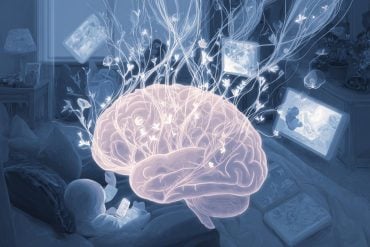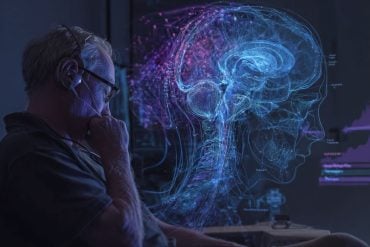Summary: Our brain doesn’t just record time—it organizes our lives into distinct, memorable moments. New research reveals that neurons in the lateral entorhinal cortex generate unique “jumps” in activity when something meaningful happens, creating bookmarks that structure our experiences.
These jumps separate the continuous flow of sensations into individual events, making memories richer and more accessible. The findings also shed light on Alzheimer’s, where this time-organizing system is among the first to fail, disrupting memory and event sequencing.
Key Facts:
- Neurons in the lateral entorhinal cortex produce unique activity jumps to mark meaningful events.
- These neural bookmarks allow the brain to organize experiences into ordered memories.
- Alzheimer’s disease disrupts this system early on, impairing memory organization.
Source: NTNU
Our brain doesn’t merely register time – it structures it, new research from the Kavli Institute for Systems Neuroscience shows.
The research team led by NTNU’s Nobel Laureates May-Britt and Edvard Moser, from the Kavli Institute for Systems Neuroscience, is already known for their discovery of the brain’s sense of place.
Now they have shown that the brain also weaves a tapestry of time: The brain segments and organizes events into experiences, placing unique bookmarks on them so that our lives don’t become a blurry stream, but rather a series of meaningful moments and memories we can revisit and learn from.

We live in a continuous stream of fleeting sensory information. How do we manage to select and segment this stream of reality into meaningful experiences we carry forward in life?
The NTNU researcher have found a “jumping” answer in a new study published in Science.
A signal that never repeats
The researchers examined a part of the brain’s memory system called the lateral entorhinal cortex (LEC). This area provides important input that helps generate our sense of time during experiences and memories.
A new technology called Neuropixels has made it possible to record from thousands of brain cells in this area simultaneously.
“What we found was that the brain cells work together to create a signal that constantly drifts in a pattern that never repeats itself – not even during sleep. This drift isn’t driven by what we do or see, but is an inherent property of the network,” said Edvard Moser, professor of neuroscience at the NTNU Kavli Institute.
It is as if this brain area is hardwired specifically to capture new sensations and experiences.
The brain creates bookmarks
“When something important, unexpected, or meaningful happens – for example, a reward, a new place, or a surprise – this signal makes a sudden jump before continuing its quiet drift. These jumps mark the beginning and end of an experience,” said Ben Kanter, first author of the study.
The researchers use the analogy of beads on a string to illustrate how our sense of time works. The string represents our subjective experience of time, which usually drifts smoothly forward. But when something important happens, the signal jumps.
Edvard Moser demonstrates this by lifting the string upwards, and May-Britt attaches a paperclip at that spot. The paperclip marks the start of a new experience – a kind of bookmark in the brain.
After that, the sense of time continues its quiet drift, with event after event threaded onto the string in the correct order, like beads on a necklace. In this way, the jumps divide the continuous flow of sensory information into distinct and meaningful experiences, organised in the sequence they actually occurred.
“These jumps give each experience a unique neural signature – a bookmark, like a barcode in the brain – making it possible to store experiences as memories and retrieve them later,” Kanter said.
Time flips our memories
The study also explains why time feels so different in the moment compared to in memory.
“A boring hour can feel long while it’s happening, but it leaves behind few memories and thus feels short in retrospect. When we’re having fun, time flies – it feels short in the moment, but we end up with many rich memories, making it feel as if we experienced more than the actual time would suggest,” said May-Britt Moser, professor of neuroscience at NTNU’s Kavli Institute.
“The brain doesn’t measure experienced time itself, but experiences. The more details and events we store, the richer and longer time appears in our memory,” said Edvard Moser.
In other words, it is our experiences and memories that create our sense of time.
An important piece in the Alzheimer’s puzzle
The findings may also have major implications for understanding dementia.
“Alzheimer’s disease often starts in the lateral entorhinal cortex – precisely where the sense of time is created,” said May-Britt Moser. “When the cells in the LEC die, it becomes harder to organize memories and understand the sequence of events.”
She illustrates this by picking up scissors and cutting the bead string Edvard is holding. The organizing thread of time is severed, and the beads – the events – spill out in disarray, without structure.
“Our goal is to understand how a healthy brain organizes time and memories. If we succeed, we may be able to develop methods to detect Alzheimer’s earlier and stop cell death before the disease causes too much damage,” she says.
At the K.G. Jebsen Centre for Alzheimer’s Disease, neuroscientists at Kavli are collaborating with neurologists at St. Olavs Hospital. They are already using this knowledge to develop biomarkers that can detect the disease early.
The ultimate goal is clear: To solve the Alzheimer’s puzzle – and give people the chance to keep their memories and their lives intact for as long as possible.
The study was carried out by Ben Kanter (first author), Christine Marie Lykken, Ignacio Polti, May-Britt Moser (senior author), and Edvard Moser (senior author) from the Moser Group at the Kavli Institute for Systems Neuroscience, NTNU.
A signal that drifts and jumps
The researchers recorded activity in the lateral entorhinal cortex (LEC), part of the brain that contributes to our sense of time. They found that:
- LEC activity drifts slowly forward without ever repeating itself, regardless of what the animal is doing – including during sleep.
• When something important or surprising happens, the signal makes a sudden jump. Activity increases rapidly at the start of a new event before settling back to baseline.
• These jumps create unique neural “barcodes” for each experience, enabling the brain to store and retrieve memories.
About this neuroscience research news
Author: Rita Elmkvist Nilsen
Source: NTNU
Contact: Rita Elmkvist Nilsen – NTNU
Image: The image is credited to Neuroscience News
Original Research: Closed access.
“Event structure sculpts neural population dynamics in the lateral entorhinal cortex” by May-Britt Moser et al. Science
Abstract
Event structure sculpts neural population dynamics in the lateral entorhinal cortex
INTRODUCTION
Our experience of the world unfolds as a stream of events that can later be reconstructed from memory in rich detail. The hippocampal formation, which is critical for such episodic memories, has been shown to exhibit slow changes in neural activity over time, most prominently in the lateral entorhinal cortex (LEC).
It remains to be determined whether and how this drift in neural activity contributes to the temporal organization of episodic memories.
RATIONALE
Experiences are segmented into discrete events across a range of timescales from seconds to minutes or more. Event boundaries (i.e., transitions between successive events, such as changes in location, social setting, or behavior) affect memory for the duration and order of events, which suggests that event structure could play an important role in shaping the neural activity underlying such memories.
To search for the neural mechanisms that determine how events are segmented and organized in time, we used high-density Neuropixels probes to record neural activity from an unprecedented number of neurons in the LEC and neighboring brain areas in freely behaving rats, across multiple behaviors and behavioral states, and in the presence of variations in event structure at multiple timescales.
RESULTS
Neural population activity in the LEC drifted continuously along a one-dimensional manifold during individual foraging sessions, such that activity traveled progressively farther away from the current state. Simultaneously recorded neural activity in the medial entorhinal cortex (MEC) and hippocampal area CA1 exhibited minimal drift.
Recordings during natural sleep revealed that LEC population dynamics were nearly identical during rapid eye movement (REM) sleep and foraging, which suggests that drift does not require changes in external sensory information and instead is an inherent network phenomenon.
During wakefulness, population dynamics abruptly shifted at event boundaries, leading to the segmentation of neural activity into discrete temporal units. During tasks with repeating temporal structure, the LEC simultaneously encoded event information across multiple timescales by traveling additionally in directions orthogonal to the drift.
We uncovered potential mechanisms of both drifting and shifting dynamics in neural population activity. Drift could be explained by minute-scale variability in the firing rate of individual neurons broadly distributed throughout the LEC population.
These slow variations were necessary and sufficient for drift at the population level. Shifts in population dynamics at event boundaries were driven by synchronous responses of neural ensembles in the LEC. Different ensembles responded at different event boundaries, such that individual events could be time-stamped in memory.
CONCLUSION
Drift of neural activity in the LEC is an inherent network phenomenon that continues at a constant rate during wakefulness and sleep but is briefly interrupted by abrupt shifts at moments of transition between events.
These results identify a candidate mechanism for the segmentation of experience into discrete episodic memories, as reported in human study participants. Experience consists of a sequence of events across a wide range of timescales, organized hierarchically from seconds to minutes or more.
We show that LEC activity simultaneously encodes event information across these different timescales without explicit reinforcement or extensive behavioral training. Together, our results identify a hierarchical neural coding scheme for organizing events in time.






